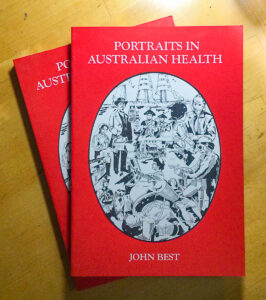 I have written this story before, but the proposal to increase the travel allowances of patients living in country areas of NSW reminds me of a story which appeared in my 1988 book “Portraits in Australian Health” released in the Bicentenary year, to my knowledge the only book which the Federal Department of Community Services and Health sponsored to honour this occasion.
I have written this story before, but the proposal to increase the travel allowances of patients living in country areas of NSW reminds me of a story which appeared in my 1988 book “Portraits in Australian Health” released in the Bicentenary year, to my knowledge the only book which the Federal Department of Community Services and Health sponsored to honour this occasion.
It related to a long time general practitioner in a northern country town in NSW who, among his diverse interests and skills, was an expert in diseases of the eyes. On one occasion, one of his patients came to see him for advice. Apparently, the advice did not suit this person, and so he sought a second opinion. This meant travelling to Sydney by train, which took about eight hours, in order to consult the eye specialist. This meant no mean effort.
Days later, he arrives at the specialist’s rooms in Macquarie Street only to find, as he entered the consulting room, there was his own country doctor who, at the time, was undertaking a locum for the specialist.
This is highly unlikely to happen today, but emphasised that just because one may prefer to practise medicine in a rural setting it is in any way different from practising in the city, apart from the technology. It just means getting the skill sets and the incentives right. But I admit that technology has in some areas supplanted a need for the same level of clinical skills, but that generality hides a much deeper discussion on its truth.
The doctor in the anecdote never lost his links with the city. When a doctor practises in a country town, he or she does so as an everyday member of the community and as the repository of the knowledge of the community’s health status, each person by person. In attracting a doctor to country practice, the community must realise that the doctor must have his or her own space, his or her own privacy – the interaction between the doctor and community, which I once termed “tolerance” – a recognition of the importance of both sides of this interaction played out beyond the doctor’s rooms.
In so doing, another element of potential dysfunction is broached – that of professional isolation. Post graduate education is offered but availability is not the same as uptake. What worried me when I served as Director of Clinical Training was to get the professionals to interact with one another, even within the one practice. I have found collegiality helps in diminishing isolation, because sometimes I think many of my colleagues would prefer a sub-specialty of one.
Over years working in rural areas, it is tragic that I have seen the same mistakes being repeated over and over again. The classic conundrum is that of the doctor who complains about his workload, but when offered another doctor, recoils because of an unsubstantiated threat to income and as a threat to the power structure these long term doctors have created in their town. As a result there is a dearth of succession planning.
The other cultural problem, for which doctors are not to blame, is that the closer one town is to another the greater the rivalry and animosity, often demonstrated in the regional sporting rivalries
Awareness of the dysfunctions of rural life is papered over by the vision of an Acadian life, but despite the attempts at regionalisation, it is always the major regional city which collects the spoils and the rest of the region is left to its own devices. There are success stories; but always it seems there is a time when former patterns of dysfunctional behaviour re-emerge.
Having the will of successive generations of administration to maintain an open co-operative system requires the steely resolve of people like the Mayo Brothers, and how they achieved their success should be studied in every institution where health administration is taught.
“Tasting the winds, that are footless,
Waist-deep in history.”
I love trees as obviously does Sylvia Plath from this above quote.
One of my most enjoyable times was driving between Bourke and Goodooga in Northern NSW with Stuart Gordon and Nick Mersiades. Stuart Gordon then was moving from growing cotton into the community services sector. He asked whether he could cadge a lift to Brewarrina, as Nick and I were going onto Goodooga to stay the night before proceeding to Hebel just over the NSW border in Queensland the next day.
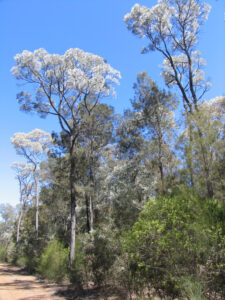
What was unforgettable about this drive was the level of knowledge of the countryside those two blokes had. The bush was varied. At one point we would be driving through predominantly brigalow scrub but at other times gidgee scrub.
Gidgee trees are stockier than brigalow and have dark trunks, which, when they are cut, yield a yellow sapwood corona surrounding an umber core. Brigalow trees are taller. In the dry area, the green brigalow foliage becomes increasingly silvery, and in a breeze I thought it to be almost feathery like giant dowager boas.
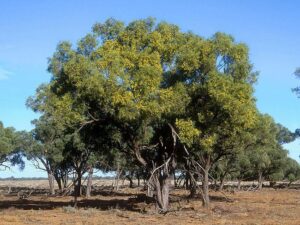
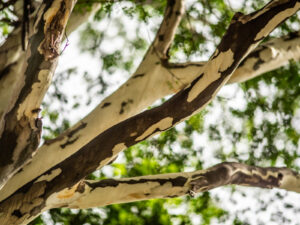
Interspersed among these stands of acacia were mallee eucalypts, and the incredibly beautiful leopard and salmon gum trees. The trunks of the latter were smooth salmon in colour and the leopard gum mimicked the spotted hide of the eponymous carnivore.
To me, crushing a gum leaf and smelling the eucalyptus oil is the most tangible reminder of who I am. Although I have been eligible for both British and Irish citizenship, however tempted, I can only be loyal to one country – Australia. Sometimes over the past decade it has been very difficult to assert such loyalty, but the sun always rises.
Some years ago, Thomas Pakenham, who is incidentally the 8th Earl of Longford, a disestablished Irish peerage, authored a number of books, among them extravagant pictorials highlighting the trees of greatest significance to the author. In the first of these, “Remarkable Trees” was an impressive arboreal array, including the oldest tree in the world, a bristlecone pine about 4,600 years old growing at an altitude of 3,000 metres in the White Mountains in California among other aged trunks in the aptly named Methuselah Grove.
Apparently there was an even older tree in which an enthusiastic geography student inserted and then broke a tree corer in trying to ascertain the age of a similar tree. The corer was valuable enough for the tree to be cut down to rescue the corer. The tree turned out to be 4,900 years old at the time of its axing. It could be said that these trees have been dying for two thousand years, but none had been beheaded in search of an instrument. Two thousand dollars for the oldest tree – a question of priorities.
Yet there were Australian trees among his remarkable trees. One was the famous prison baobab near Derby in the Kimberley. Another was the bunya pine next to a grand castle in Northern Portugal. The height of this pine is comparable to the castle’s campanile tower. In our garden here in Sydney we have had a number of bunya pines which we once bought in the Bunya Mountains south-west of the Queensland town of Kingaroy.
Fortunately the remaining one still grows in a pot, saving us from worrying about a putative 45 metre tree overshadowing the whole of our front garden. Australia is thought of as being gum and wattle trees, but Australia is also home to many of the Araucaria relatives of the bunya pine, the most recent member of this genus being the Wollemi pine, named for the wilderness area in the Blue Mountains where it was first discovered.
This book was followed by “Australia’s Remarkable Trees” – another impressive pictorial. I once wrote to its authors Richard Allen and Kimbal Baker, pointing out that there was this remarkable tree at the corner of Punt Road and Alexandra Avenue in Melbourne. It is a huge golden elm at the intersection of these two very busy roads on the banks of the Yarra River.
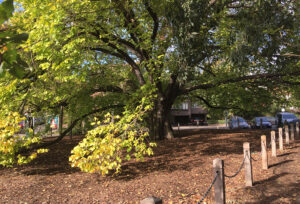 The amazing element which I found as I entered the dense canopy, seeking an unmarked specimen of leaf, at a time when I was collecting the various glabrous leaves of these trees, was that when you were under the canopy your vision was only of the foliage. The outside world was blotted out. Branches nearly touch the ground, and others are propped up. Here, there was a tranquillity, and even though close by, the traffic noise was muted, although the smell of the dusty, dirty city does penetrate through the foliage.
The amazing element which I found as I entered the dense canopy, seeking an unmarked specimen of leaf, at a time when I was collecting the various glabrous leaves of these trees, was that when you were under the canopy your vision was only of the foliage. The outside world was blotted out. Branches nearly touch the ground, and others are propped up. Here, there was a tranquillity, and even though close by, the traffic noise was muted, although the smell of the dusty, dirty city does penetrate through the foliage.
Most of the foliage bore the scars of insects – it was mid-summer and cool under the foliage. Close up the imperfections in the leaves were very evident. But that is life. The tree appears in the book, and the authors suggest the best time to view the tree is in spring when the foliage is unmarked, a lighter shade of green than its companion elms. Given in Europe that the English elm has been almost wiped out by Dutch elm disease, Melbourne and also other places like Ballarat are major remaining strongholds on Earth of this remarkable tree.
All such books as I describe are based on informed subjectivity. However there is one thing binding all these trees and that is of a deep appreciation, if not awe, of the permanent diverse planet upon which we move about. Thus, when one hears of destruction, it is often a time when I mourn for this lost heritage, as if one has lost a member of the family.
Fire is an ever-present risk to our forests. For some slow growing trees like snow gums it is a ghastly fate, but for others such as banksia it is important for the generation of new stock. The greater danger is overlogging, which has dogged Australia throughout our history. It seems that if you are born Tasmanian, you are born an instinctive forester. A forester is OK; but an indiscriminate logger is a vandal. The stories abound of such destruction in Tasmania, which continually change the undoubted resilience of trees such as the trio of its indigenous pines – the Huon, king billy and celery.
Trees deserve our attention. They are part of us. The introduction of the deciduous exotica, which provide Australia with all the autumnal colour, is probably one of the positive contributions from the colonial Heritage.
Thus, many of us take trees for granted, and when we talk about trees, the appreciation of diversity is unfortunately limited to whether the tree is obstructing my view or not.
A Virus in the Sand
At a time when the rise in the number of cases of Covid in Australia has been dramatic, the following article from the NYR shows a thoughtful perspective as it describes what the new medical graduate must expect. Much of the clinical experience of all these young health professional graduates would have been in a period when the COVID-19 pandemic dominated health care and the resultant priorities arising. I have read these thoughts, and the stark manner in which ICU practice has been affected in modern medical practice with the advent of a contagious disease dominating the acute patient load.
At the same time, there are the challenges presented by its persistence as the chronic disease in all its manifestations; such as the phenomena of active long COVID or dormant COVID reappearing decades later.
This is a virus which is both deadly and seemingly innocuous, depending on the particular individual response. Whether it creates a deep ravine in medical practice, between infectious and non-infectious disease will ultimately depend on how the organisation of the health care system changes both now and after the pandemic has waned– the resurrection of infectious disease hospitals for instance.

Paradoxically, Australia has spent a considerable amount of money on health institutions, often driven by clever marketing of sub-specialities, with an advocacy group of those affected by the particular condition and their relatives, especially if the affected person has a strong public profile.
The level of sub-specialisation and the disproportionate incentives for this to occur only serves to magnify the cost of health care. Children are an irresistible magnet for funding; and beware any attempt to interfere. Try a review of funding for childhood cancer – impossible to review objectively as to cost effectiveness because of the emotional halo.
A subspecialty exists because, through skill or advocacy, it has carved itself away from a perceived drudgery of general practice. This view has been increasingly encouraged by the various deans of health sciences in universities, where excellence is determined by the amount of research funding and by the number of citations, notoriously subject to gaming.
This obsession with rankings based on the alleged quality of research has been increasingly dissociated from the prime reason for universities to exist – and that is to teach each generation of students in the best available environment. Plus, may I add, not to have half the Faculty away on overseas conferences, on sabbaticals and/or time spent in private practice and outside consultancy work. This state of affairs is hardly conducive to healthy pedagogy.
The doctors who are finishing residency now have completed most of their training in a world without robust family presence. They learned to become doctors to patients who are intubated and under deep sedation, behind closed doors, in a world of masks and alongside the fear that if they are not careful, their patients could make them sick.
Back in my own training, we used deep sedation and paralysing medications infrequently, as we knew that these decisions came with a cost: delirium, long-term brain dysfunction, profound weakness. But today’s doctors in training have learned on Covid patients. When we were uncertain what to do, particularly early on, we reflexively jumped to deep sedation as the answer for them. These are patterns that are hard to unlearn.
And beneath it all is the continued spectre of the virus. Though I did not have a single patient with Covid-19 during my recent weeks in the unit, from time to time, we would receive a message alerting us that one of our patients had a Covid exposure from a staff member who had tested positive and would have to be on precautions as a result. Patients and families were once terrified by this news, but now they are largely used to it and seem reassured that the staff are masked and so any meaningful exposure is unlikely. This is another aspect of our new reality.
To think that a possible Covid exposure would not cause panic is itself a sign of great progress. But at the same time, we are so far from where we thought we might be by now. When I walked through the halls of the Covid intensive care unit back in the spring of 2020, I told myself, as did so many of us in health care, that we would improve care for those who were disproportionately impacted by this virus. The systems to which we had become accustomed would be dismantled, and we would find ourselves somewhere better.
But those sorts of promises are naïve and empty without a plan for how to make and sustain real change to protect the vulnerable among us. So here I am, back in the unit, caring for a patient with severe cerebral palsy, who had aspirated his own secretions and developed a life-threatening pneumonia. His aging parents had done the best they could despite limited resources, making sure to turn their adult son on his side multiple times a day to help him cough, but his muscles were too weak. And now he would require a tracheotomy tube for the rest of his life. I know, talking to his parents, that it is possible that their adult son will not go home, that they will not be able to afford the kinds of services he needs. When and if another virus comes, the son they cared for at home for three decades might be living in precisely the kind of nursing facility that will be decimated by it. It’s easy to feel that the tragedy only repeats.
But then again, in just a few weeks, a group of newly minted doctors begin their internships. Medicine is strange like that, a new generation every three years, and with it a chance for reinvention. They will find themselves in a hospital in transition, in a country that has suffered more than a million deaths. We will teach them about all of it, about how to manage sepsis and heart failure and trauma, about the pandemic and how it was before. And for a moment, maybe, we can step back and see it all through their eyes — the nervousness and the excitement and, more than anything, the hope for what is to come.
Oolong or Earl Grey?
In a previous blog, I worried about the many deficiencies in our approach to the other nations of the South Pacific.
The Chinese might have the money, but Australia has the advantage of Foreign Minister, Senator Penny Wong, who has turned disdain to genuine respect for our South Pacific community. This has been coupled with a change in the Government’s attitude to climate change, to make it easier for the Australian government to adopt a primus inter pares role in the South Pacific area.
Every nation in the South Pacific has been victim of colonisation. China in its entry into the South Pacific is just another coloniser, although the gunboat may be muted, the offered funding comes clutched in a mailed fist.
Therefore, the European countries have been a major factor in the sometimes idiotic distribution of their colonies. Does it make sense that the Western part of New Guinea has been hived off into Indonesia just because it was once the furthest outpost of Dutch colonisation.
One remnant of Portugal’s worldwide speckled colonisation is the Republic of Timor-Leste, whose isolation in a region of muted hostility makes it not unexpectedly seek a powerful ally, such as China. Previously East Timor, as it was before Independence, has always presented an anomaly. Whitlam was worried that East Timor, if it received such independence, would present a risk of an Arafura Cuba.
However any hidden intervention then has been well and truly trumped by the disgraceful behaviour of the Australian Government, as described in the Crikey newsletter namely the bugging of the Timor-Leste cabinet, the motives of the Howard government in its tactics towards the fledgling state, the subsequent decisions of the then foreign minister and then DFAT secretary to take jobs with the biggest beneficiary, the abuse of intelligence agencies for corporate espionage, the attempts to cover up the truth of the bugging and the vexatious attempts to punish those who exposed that truth, amount to the greatest scandal of recent decades.
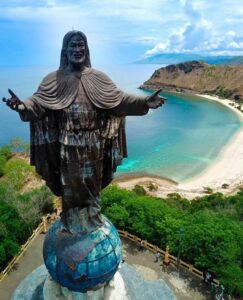
Successive Australian governments have concealed such chicanery that will make any long term relationship between the Republic and ourselves very shaky. Australia has a substantial Timorese population in Darwin, and having been there just before the pandemic, it was to me clear how much the Chinese were investing in the Timor-Leste infrastructure. While the Republic shares the island with Indonesia, it is also a short boat ride from Dili across to the Indonesian island of Alor, part of the extended archipelago of the Southern Sunda islands, one of which Bali is 1,600 kilometres to the west of Alor.
Setting Timor-Leste aside for a moment is not to ignore its importance in a cohesive Australian South Pacific strategy lacking up to now.
Apart from a perception of the Chinese being a new colonial power, one of the points of differentiation is for Australian government ministers to cease to act as colonial masters. The Chinese have difficulty in hiding their sense of superiority, which grates, and in the end makes their presence in the South Pacific unpalatable. Nevertheless, mate, money takes away any distaste.
As I wrote about Andrew Peacock’s actions when he inherited the Ministry of External Territories, he immediately treated the New Guineans as equals, so evident in his relationship with Michael Somare. His predecessor was an old school Country Party politician, who viewed coloured people as inferior. After all, we’ve lived through a long term White Australia policy, and it is testimony to countervailing factors which have assured our role among out neighbours – not the least of which was our generation in speaking out against such a policy.
One of these factors binding us together undoubtedly is rugby; and with that New Zealand and its indigenous Maori population provide a vital bridge to Polynesia. This the Chinese do not have,
Our mutual Anglo-Celtic background provides a deceptive similarity of Australia with New Zealand. Yet it is in part mirage. As one who has headed a hybrid Australian and New Zealand organisation, I found the countries to be very different; the two nations respond differently to external stimuli. As with all neighbours, there is an accumulation of negative factors, which will intrude into all the positive aspects, unless we both recognise and deal with the differences immediately. Recently in her new role, Penny Wong has ably demonstrated with her embrace of the NZ Foreign Minister, Nanaia Mahuta, with her facial moko, her ability to confront the cultural differences. Whatever may be unstated, facial tattoos are confrontational for a country not steeped in Polynesian culture as New Zealand is.
Melanesia, as shown by the Solomon Islands treaty with China, exhibits our vulnerability; this is intertwined in our relationship with Papua New Guinea. Papua New Guinea is a nation borne out of strong colonial links with Australia, both direct with Papua and by the acquisition of a mandate of the German colony of New Guinea after WW1.
Our indigenous Aboriginal people are represented in some of the Southern Sunda islands but more as an anthropological curiosity than as any cohesive force.
There are the Torres Strait People and here the Australian border with PNG provides a problematic divide. Then there is the collection of South Seas islanders – the descendants from the nineteenth century kanaka trade. Predominantly men from Vanuatu, they were press-ganged to work the cane fields of Northern Queensland, and Mackay is where many of the descendants remain. They have their identity, their flag but are not recognised in the same way Torres Strait Islanders are recognised. Only a small fraction of white Australia has ever met a Torres Strait islander. Yet some of the greatest rugby league players have come from both Torres Strait and South Seas Islanders.
On the other hand, the Solomon Islands were always a British colony before independence in 1978; and the Republic of Vanuatu was born from the New Hebrides condominium arrangement between Britain and France in 1980.
France remains the only European power left in the South Pacific and there is no indication that it will leave soon. One of the lessons was our ability to mobilise against the common enemy – this was the French when they were conducting nuclear testing in the South Pacific. We ran a meticulous campaign against the French and, given its modest funding, was very successful if judged by its impact among some of the South Pacific nations, remembering I was fronting an Australian and New Zealand organisation.
One area of which both our nations are guilty is still the magnetism of Great Britain, even though despite some Whitehall protestations, Britain has long since vacated the South Pacific. The AUKUS arrangement is redolent of a backward looking, nostalgic stream of thought.
Hopefully as an early priority Wong will not rush over to the “old Country” to tug the forelock or have tea at Windsor. Fortunately, she seems to have left that to the emissary of the old huntin’ and shootin’ brigade, garbed as an Edwardian remnant of Albion humankind, a man whose name conveniently rhymes with dandy. Leave the UK to these people and let’s get on with dealing with the actual challenges of our region.
We marshalled the forces against one form of climate change 25 years ago. The challenge presented by climate change is far more serious and instead of AUKUS, how about a South Pacific alliance against the great polluter, China. Unfair characterisation? Fairness is not a major constituent in Chinese foreign policy. I am sure that matter is foremost in the Penny Wong mind.
Some are advocating Australia enact a form of the Monroe Doctrine. Next blog I shall discuss this proposal, given it seems to have some currency.
Mouse Whisper
Have you noted those advertisements, where the dentist has his back to the viewer, brandishing what is ostensibly a tooth brush. If you look in the mirror, there is no reflection of the dentist.
Now what a subtle advertisement. Toothbrushes and garlic toothpaste?
As some other rodent has said: “Real vampires do exist – they are life sucking people that are narcissistic, greedy, selfish and vain. They take from you as much as they can. They “seem” to be friends and offer you pleasure and beauty but they take your life. They cannot see their reflections because they portray someone other than their true self.”
In the end, as they say, this is no reflection on anybody.

